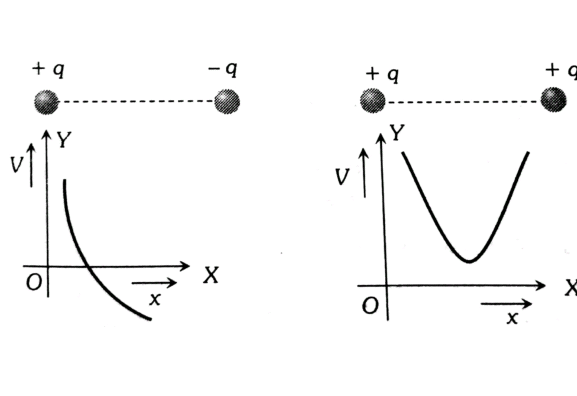Amity University-Noida B.Tech Admissions 2026
Among top 100 Universities Globally in the Times Higher Education (THE) Interdisciplinary Science Rankings 2026
Electric potential is considered one of the most asked concept.
85 Questions around this concept.
Two thin wire rings each having a radius R are placed at a distance d apart with their axes coinciding. The charges on the two rings are +Q and -Q The potential difference between the centers of the two rings is
Figure shows three points $A, B$, and $C$ in a region of uniform electric field $\vec{E}$. The line $A B$ is perpendicular and $B C$ is parallel to the field lines. Then which of the following holds good? Where $V_A, V_B$, and $V_C$ represent the electric potential at points $A, B$, and $C$ respectively.
A cube of a metal is given a positive charge Q. For the above system, which of the following statements is true
New: JEE Main 2026 City Intimation Slip Link
JEE Main Sample Papers: Physics | Chemistry | Maths | Top 30 Repeated Questions
JEE Main QP & Mock: Previous 10 Year Questions | Chapter Wise PYQs | Mock test Series
An arc of radius $r$ carries charge. The linear density of charge is $\lambda$ and the arc subtends an angle $\frac{\pi}{3}$ at the center. What is the electric potential at the center?
An electric charge $10^{-3} \mu C$ is placed at the origin $(0,0)$ of $X-Y$ co-ordinate system. Two points A and B are situated at $(\sqrt{2}, \sqrt{2})$ and $(2,0)$ respectively. The potential difference between the point $A$ and $B$ will be
A charge Q is uniformly distributed over a long rod AB of length L, as shown in the figure. The electric potential at the point O lying at a distance L from the end A is :

Two points are maintained at the potentials of 10 V and -4 V respectively. The work done in moving 100 electrons from
is
A charge (– q) and another charge (+Q) are kept at two points A and B respectively. Keeping the charge (+Q) fixed at B, the charge (– q) at A is moved to another point C such that ABC forms an equilateral triangle of side l. The net work done in moving the charge (– q) is
This question contains Statement-1 and Statement-2. Of the four choices given after the statements, choose the one that best describes the two statements.
Statement-1: For a charged particle moving from point to point
, the net work done by an electrostatic field on the particle is independent of the path connecting point
to point
.
Statement-2: The net work done by a conservative force on an object moving along a closed loop is zero.
Amount of work to bring a unit positive charge from infinity to certain point is defined as,
In an Electric field Electric potential V at a point, P is defined as work done per unit charge in changing the position of test charge from some reference point to the given point.
Note-usually reference point is taken as infinity and potential at infinity is taken as Zero.
We know that
$
W_{e x t}=\int \overrightarrow{F_{e x t}} \cdot \overrightarrow{d r}
$
Since
$
W_{\text {ext }}=\Delta U \text { and } \Delta K E=0
$
$\Rightarrow {\text { For all time }} F_{n e t}=0$
$\Rightarrow \vec{F}_{\text {ext }}+\vec{F}_{\text {system }}=0$
i.e $\vec{F}_{\text {ext }}=-\vec{F}_{\text {system }}$
So $V=\frac{W_{\text {ext }}}{q_0}=\int \frac{\vec{F}_{\text {ext }} \cdot \overrightarrow{d r}}{q_0}=-\int \frac{\vec{F}_{\text {system }} \cdot \overrightarrow{d r}}{q_0}$
where
$V \rightarrow$ Electric potential
- It is a scalar quantity.
SI Unit $\rightarrow \frac{J}{C}=$ volt ${ } {\text {while CGS unit is stat volt }}$
1 volt $=\frac{1}{300}$ stat volt.
- Dimension -
$
[V]=\left[\frac{W}{q_0}\right]=\left[\frac{M L^2 T^{-2}}{A T}\right]=\left[M L^2 T^{-3} A^{-1}\right]
$
Electric Potential at a distance 'r'
If the Electric field is produced by a point charge q then
$\begin{aligned} & F=\frac{K q q_0}{r^2} \\ & \qquad \begin{array}{l}V=\frac{W_{\text {ext }}}{q_0}=\int \frac{\vec{F}_{\text {ext }} \cdot \overrightarrow{d r}}{q_0}=-\int \frac{\vec{F}_{\text {system }} \cdot \overrightarrow{d r}}{q_0} \\ \qquad V=\frac{K q}{r} \\ \quad \text { at } r=\infty \quad V=0=V_{\max }\end{array}\end{aligned}$
Electric Potential difference
In the Electric field, the work done to move a unit charge from one position to the other is known as Electric Potential difference.
If the point charge Q is producing the field
Point A and B are shown in the figure.
$V_A$=Electric potential at point A
$V_B$=Electric potential at point B

$r_B \rightarrow$ the distance of charge at $B$
$r_A \rightarrow$ distance of charge at $A$
$\Delta V=$ The Electric potential difference in bringing charge q from point A to point B in the Electric field produced by Q .
$
\begin{aligned}
& \Delta V=V_B-V_A=\frac{W_{A \rightarrow B}}{q} \\
& \Delta V=K Q\left[\frac{1}{r_B}-\frac{1}{r_A}\right]
\end{aligned}
$
- Superposition of Electric potential
Statement- Total electric potential at a given point in space due to all the charges placed around it is the scalar or algebraic addition of electric potential due to individual charges at that point.
i.e
The net Electric potential at a given point due to different point masses $\left(Q_1, Q_2, Q_3 \ldots\right)$ can be calculated by doing a scalar sum of their individuals Electric potential.
$
V=V_1+V_2+V_3+\cdots=\frac{k Q_1}{r_1}+k \frac{Q_2}{r_2}+\frac{k\left(Q_3\right)}{r_3}+\cdots=\frac{1}{4 \pi \varepsilon_0} \sum \frac{Q_i}{r_i}
$

- Electric Potential due to Continuous charge distribution
$
V=\int d V=\int \frac{d q}{4 \pi \varepsilon_0 r}
$
As we move on the line joining two charges then the variation of Potential with distance is given below.

1.For internal point
(It is assumed that $\left|Q_1\right|<\left|Q_2\right|$ )
Let at $P, V$ is zero
$
\begin{aligned}
& V_P=0 \Rightarrow \frac{Q_1}{x_1}=\frac{Q_2}{\left(x-x_1\right)} \\
& \Rightarrow x_1=\frac{x}{\left(Q_2 / Q_1+1\right)}
\end{aligned}
$

If both charges are like then the resultant potential is not zero at any finite point.
2.For external point
Let at P, V is zero

$\begin{aligned} & V_P \Rightarrow \frac{Q_1}{x_1}=\frac{Q_2}{\left(x+x_1\right)} \\ & \Rightarrow x_1=\frac{x}{\left(Q_2 / Q_1-1\right)}\end{aligned}$
"Stay in the loop. Receive exam news, study resources, and expert advice!"
